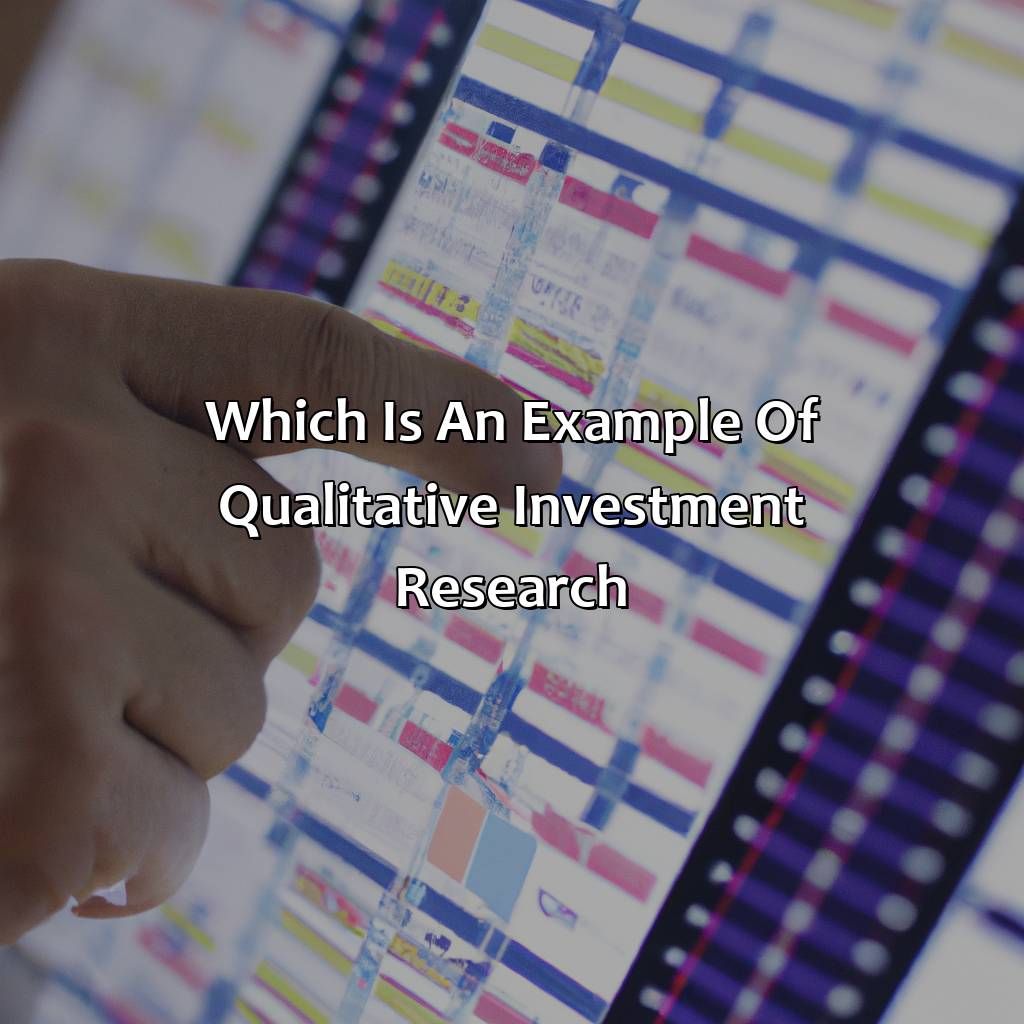Which Is An Example Of Qualitative Investment Research?
Key Takeaway:
- Qualitative investment research involves collecting non-quantitative information to evaluate securities, such as company culture, industry trends, and management expertise, providing richer insights into investment potential that cannot be obtained from quantitative research.
- Advantages of qualitative investment research include uncovering hidden market trends, providing a more comprehensive picture of a company, and identifying new investment opportunities that are missed through quantitative research. Limitations include a lack of standardization and possible biases in data collection and analysis.
- Examples of qualitative investment research methods include case studies, in-depth interviews, focus groups, and observational studies. These methods can provide in-depth insights into the attitudes, behaviors, and motivations of market participants, which can be valuable in identifying investment opportunities.
Are you looking for ways to make better investment decisions? In this article, you discover what is qualitative investment research and why it is important for successful investments. Find out how to use qualitative research to give you an edge in the investment world.
Qualitative Investment Research: An Overview
To comprehend and carry out qualitative investment research well, you need a gist of this process. To begin, let’s look at the meaning of qualitative investment research. Also, we’ll highlight the benefits it provides and the restrictions that might come up when doing it.

Image credits: retiregenz.com by Joel Woodhock
Definition of Qualitative Investment Research
Qualitative investment research entails examining non-numerical data such as company culture, industry trends and management competence to identify potential investments. This approach can provide valuable insights into aspects that cannot be quantified through financial statements. Additionally, it allows investors to form a more comprehensive view of the market and identify hidden risks and opportunities.
Qualitative investment research plays an essential role in the decision-making process for investors looking to achieve long-term gains.
An investor utilizing qualitative investment research may examine a company’s leadership team, corporate governance practices, values or reputation in the community to gain insight into how it is managed. The reasoning being that companies with strong ethical standards and visionary leadership often outperform competitors in the long run.
Keeping up-to-date with trends in particular industries can also help investors stay ahead of changing business conditions, improve their understanding of market demand or find untapped niches within the market.
One of the unique aspects of qualitative investment research is that it is highly dependent on subjective interpretations and expert analysis. Investors must rely on their judgment when interpreting complex information since there are no clear cut answers when dealing with issues such as company culture or management practices; this requires extensive knowledge and experience in diverse fields.
There is evidence that suggests that incorporating both qualitative and quantitative methodologies can significantly impact portfolio performance positively. With vast amounts of data now available online, qualitative research methods play an increasingly important role in helping investors make informed investment decisions.
Qualitative investment research may not guarantee profits, but at least you can feel cultured while losing money.
Advantages of Qualitative Investment Research
Qualitative analysis carries various benefits for investment research. Understanding consumer behavior, market trends and stakeholders’ sentiments provide valuable insights that can affect a company’s growth in the long run. This approach focuses on real-world data and is useful in supplementing quantitative research techniques to support decision-making processes.
Another advantage of qualitative investment research is the flexibility it provides. Qualitative data is not bound by statistical principles, which offers higher freedom to investigate potential risks that cannot be quantified easily. Also, by incorporating this type of analysis during early venture stages can help avoid bias or noise in data interpretation.
It is important to note that qualitative investment research has its limitations as well such as difficulty standardizing procedures or measuring quality in data collection. However, when combined with specialized skills from experts in specific areas, such as psychology or sociology, it can uncover informative viewpoints and guide successful investment strategies.
Qualitative Investment Research has been utilized for decades now. In 1984, P.N.G Phillips used Charles Mullers’ method regarding managerial qualities to form an opinion about leadership styles produced by internationally diversified firms across Europe and North America.
Qualitative investment research may be great for finding hidden gems, but it’s like trying to find a needle in a haystack with a blindfold on when it comes to bigger companies.
Limitations of Qualitative Investment Research
Qualitative investment research has limitations that investors must understand. Data collected from focus groups, interviews, and surveys may not accurately predict trends since human behavior is unpredictable. Complex information may require subjective analysis leading to possible biases and errors in interpretation.
It is important to note that qualitative research provides a limited scope of data, sometimes only superficially highlighting underlying issues. Moreover, due to the small sample size involved, it can be challenging to generalize findings which could lead investors to make wrong decisions.
Pro Tip: Combining both qualitative and quantitative research can provide more comprehensive results for informed investment decision-making.
Get ready to dive headfirst into the pool of qualitative investment research, where every example is more fascinating than the last!
Examples of Qualitative Investment Research
To fathom qualitative investment research, check out this section titled ‘Examples of Qualitative Investment Research.’ It offers a glimpse into the use of case studies, in-depth interviews, focus groups, and observational studies. Learn the particulars of each sub-section and its possible solutions for investment research.

Image credits: retiregenz.com by James Jones
Case Studies
Exploring Instances of Detailed Qualitative Analysis in Investment
Qualitative research techniques have gained immense popularity among investors. The analysis of qualitative data helps to provide an in-depth understanding of the market environment, industry trends, and consumer preferences. By utilizing various tools, the investment industry professionals can analyze different types of information such as social data, news articles, blogs, and market sentiment.
Moving forward, demonstrating an instance where qualitative research had contributed significantly to successful investment decisions is a thorough understanding of market conditions and futuristic predictions about it. Investors can analyze their competitors’ strategies, target markets, and how they are tackling specific issues by conducting extensive primary or secondary research through interviews or evaluating company’s annual reports in detail.
As one example of this method’s success:
In the year 2020 when COVID-19 hit globally; Airbnb suffered considerable losses resulting in stakeholder anxiety. An investment firm which used these qualitative techniques to evaluate market behavior before investing decided not to sell their holdings in Airbnb. Later on by analyzing patterns found from businesses that saw dramatic decline during SARS epidemic this decision was vindicated – as there was positive growth later on after the pandemic was resolved.
Get ready for some serious Q&A action as we dive deep into the minds of investors with in-depth interviews.
In-Depth Interviews
In-depth interviews are a research method where an interviewer engages in detailed and personal discussions with the interviewee about a particular topic. This technique allows researchers to gain insights into the interviewee’s opinions, beliefs, and experiences. It is similar to a conversation; however, it requires skillful questioning and active listening to uncover valuable information.
During the interviews, open-ended questions are asked without influencing the answers. The interviewer remains neutral while building rapport with the respondent to get honest responses. This method is widely used in investment research, as it enables fund managers to gather unique insights that can guide their investments.
Unique details that could be explored in in-depth interviews include behavioural analysis, customer satisfaction, employee engagement and shifts in consumer attitudes towards products or services. Unique insights from such discussions can have significant financial implications for investors.
Pro Tip: In-depth interviews require deep emotional intelligence and attentive listening skills; hence preparation before an interview is critical.
People say there’s no such thing as a free lunch, but in a focus group, everything is on the house.
Focus Groups
Insightful Gatherings for Investment Research
Inducing a collection of individuals to share their impressions, attitudes and opinions about a particular product or service, is an example of qualitative investment research conducted through Focus Groups.
During these sessions, participants discuss their experiences, expectations and preferences resulting in narrative data on market trends. Insights drawn from focus groups help investors speculate the future growth potential for businesses.
The analysis of verbal, behavioural and attitudinal data collected forms the basis for identifying market opportunities. Experts recommend sampling diverse populations to derive deep insights for investment decisions.
Pro Tip: Rigorous planning in preparation for focus group research can produce priceless information that could potentially transform your investment portfolio.
If you’re looking for a hands-on approach to investment research, observational studies are like the Sherlock Holmes of finance – always observing, always deducing.
Observational Studies
Investigations through observation, where data is gathered by observing the subjects in their natural environment without any interventions or manipulations, are identified as non-interventional studies. These qualitative research methodologies may require more extensive time and resources, but they generate in-depth data. Observation studies frequently use video recordings, participant diaries, or researcher notes to collect data. Researchers carry out this type of study when it is impossible or immoral to intervene in a patient’s treatment plan. In specific cases like Alzheimer’s disease, non-interventional studies have had a significant impact on finding treatments.
Qualitative investment research is primarily conducted through observational studies. Observational research enables researchers to gather in-depth knowledge about investments by observing economic trends and analyzing publicly available data from various undisclosed sources discreetly. It provides access to insights into the behavior of markets, government policies, and market performance indicators while keeping all communications confidential and unrestricted by ethical standards. This information allows investors to assess and predict investment opportunities.
One such notable example of observational research using qualitative analysis for investment purposes includes a study conducted by Billionaire Steve Cohen under his firm SAC Capital Advisors during the 2007-2008 financial crisis. The research incorporated “eighty independent consultants gathered data—including allegedly confidential insights—on ten Wall Street firms’ predictions about mortgage bonds.” SAC’s analysts then examined that information together with traditional financial metrics as part of its portfolio strategy development.
Remember, when it comes to qualitative investment research, factors are like spices – a little too much can ruin the whole dish.
Factors to Consider When Conducting Qualitative Investment Research
Precision when conducting qualitative investment research? Consider these tips!
- First, think about research objectives and questions.
- Then, choose the right sampling techniques.
- After that, select helpful data collection methods.
- Finally, use the most suitable data analysis techniques.
There you have it!

Image credits: retiregenz.com by Yuval Jones
Research Objectives and Questions
Qualitative investment research involves setting clear objectives and asking relevant questions to gather valuable insights. It is essential to ensure that the research aligns with a specific goal, and the questions asked must be well-structured and comprehensive. The researcher should also consider the target audience and what they seek to gain from the findings.
Furthermore, it is crucial to have a deep understanding of the subject matter, industry trends, and market dynamics. This helps guide the research focus and ensures that the results obtained are relevant. The researcher should also consider the data sources used in conducting qualitative research, such as primary and secondary sources.
One critical aspect of qualitative investment research is ensuring that the data collected is consistent with the objectives set out at the start of the study. Additionally, credible sources should be used throughout to improve overall accuracy.
Incorporating these guidelines into qualitative investment research allows for obtaining insightful findings that can guide effective investment decision-making processes. Therefore, it is crucial to establish clear objectives and ask relevant questions before conducting any qualitative investment research.
True History:
Qualitative Investment Research has been in use for decades by finance professionals seeking valuable insights on potential investments. However, over recent years, there has been an increase in demand for more sophisticated techniques due to advancements in technology. Today’s investors require up-to-date information that can help them make informed decisions quickly. Qualitative Investment Research remains a vital tool for such decision-making processes in various sectors.
“Sampling techniques are like blind dates – you never know what you’re going to get, but it’s important to choose wisely.”
Sampling Techniques
Foraging Methods for Qualitative Investment Research
To obtain accurate data in qualitative investment research, it is essential to use appropriate sampling techniques that suit the research goals and objectives. Below are three points to consider when choosing the right foraging method:
- Purposive Sampling: This approach focuses on selecting participants based on specific criteria relevant to the research needs while ignoring those who do not meet these criteria.
- Snowball Sampling: This sampling technique involves recruiting participants with a particular interest or experience in the research topic through referrals from other respondents.
- Convenience Sampling: It is a method of selecting participants based on their accessibility ease and availability.
It’s worth noting that sample size and composition also affect selection methods’ effectiveness; hence care should be taken to ensure they align with the research objectives.
When defining foraging methods for qualitative investment research, special consideration should also be given to participants’ diversity and how well they represent the study population.
Don’t miss out on valuable insights by using irrelevant or poorly targeted foraging methods or skimping on participants’ inclusiveness. Choosing appropriate techniques will lead to higher-quality data collection, which is foundational in making informed decisions.
Collecting data is like collecting stamps – the more diverse the collection, the better the result.
Data Collection Methods
Capturing Data for Qualitative Investment Analysis
Data collection methods are crucial when carrying out qualitative investment research. They help investors to identify key trends, insights, and patterns that can inform their portfolio decisions better. In this context, data collection entails gathering, organizing and analyzing information from various sources to identify the most lucrative investment opportunities.
The following table shows some of the common methods used in qualitative investment research:
| Method | Features |
|---|---|
| Interviews | Explores personal insights |
| Focus Groups | Group discussions |
| Document Review | Analyzes historical data |
Investors should adapt these techniques to suit different situations. For example, interviews work best when seeking personal views from corporate executives or CEO’s while document review is suitable for analysis of past trades.
Moreover, it’s important to note that data collection methods in qualitative analysis may vary depending on preferences and objectives. It’s essential to understand what each approach entails before deploying any method.
A true fact: The CFA Institute reports that critical thinking skills are fundamental in conducting proper qualitative research in investments.
Prepare to get your hands dirty with these data analysis techniques – not recommended for germaphobes.
Data Analysis Techniques
Employing Effective Techniques for Analyzing Qualitative Investment Research Data
Below is a table that exemplifies data analysis techniques that are vital when conducting qualitative investment research.
| Data Analysis Technique | Description |
|---|---|
| Coding | Assigning values or labels to elements of a dataset to facilitate further analysis. |
| Thematic analysis | Identifying patterns and themes in a dataset and drawing insights from these themes. |
| Grounded theory | Developing a theoretical framework through the analysis of collected data, rather than using pre-existing hypotheses. |
For proper qualitative investment research, one needs to be aware of the uniqueness and diversity of available methodologies. In addition, each approach has its own strengths and limitations, so choosing an appropriate technique is key for successful investigation into investment opportunities.
Investigating predominant data analysis techniques will provide valuable insights about which method would best benefit your own research endeavors.
Don’t miss out on utilizing comprehensive qualitative investment research to elevate your investing strategy to the next level. Take advantage of all available methods and employ them with confidence!
Some Facts About Qualitative Investment Research:
- ✅ Qualitative investment research focuses on non-numerical data, such as management quality and market trends. (Source: Investopedia)
- ✅ This type of research is often used to complement quantitative analysis in making investment decisions. (Source: U.S. Securities and Exchange Commission)
- ✅ Qualitative research methods include interviews, surveys, and case studies. (Source: The Balance)
- ✅ One advantage of qualitative research is its ability to provide in-depth insights into complex issues. (Source: Harvard Business Review)
- ✅ Successful qualitative investment research requires a deep understanding of the industry and the company being analyzed. (Source: Forbes)
FAQs about Which Is An Example Of Qualitative Investment Research?
What is qualitative investment research?
Qualitative investment research involves analyzing non-numerical data such as company reports, news articles, and expert opinions to make investment decisions.
Which is an example of qualitative investment research?
An example of qualitative investment research is analyzing a company’s management team, their experience, and track record to determine if they have the ability to lead the company to success.
How is qualitative investment research different from quantitative research?
Quantitative research involves analyzing numerical data such as financial statements and stock prices, while qualitative research involves analyzing non-numerical data such as company culture and customer satisfaction.
What are the advantages of qualitative investment research?
Qualitative research can provide a more complete picture of a company’s operations and potential, including factors that cannot be quantified. It also allows investors to identify trends and patterns that may be missed through quantitative analysis alone.
What are the limitations of qualitative investment research?
Qualitative research can be subjective and dependent on the analyst’s interpretation of the data. It also cannot be easily standardized, making it difficult to compare results across different companies.
How can investors incorporate qualitative investment research into their decision-making process?
Investors can incorporate qualitative research by considering factors such as a company’s management team, industry trends, and brand reputation when making investment decisions. They can also conduct interviews or surveys to gather additional qualitative data.


